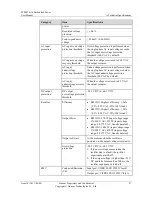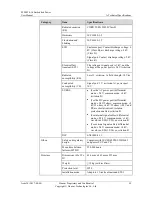
ETP4830-A1 Embedded Power
User Manual
7 Maintenance
Issue 10 (2017-08-08)
Huawei Proprietary and Confidential
Copyright © Huawei Technologies Co., Ltd.
50
7.2.18 Rect Protection
Possible Causes
The rectifier input voltage is too high.
The rectifier input voltage is too low.
The ambient temperature is too high.
The rectifier is abnormal.
Measures
1.
Check whether the AC input voltage exceeds the upper threshold for rectifier working
voltage. If so, locate and rectify the power supply fault and restore the power supply.
2.
Check whether the AC input voltage is below the lower threshold for rectifier working
voltage. If so, locate and rectify the power supply fault and restore the power supply.
3.
Check whether the ambient temperature is higher than the maximum operating
temperature of the rectifier. If so, locate and rectify the temperature control system fault.
4.
Remove the rectifier that has generated the alarm and reinstall it after the indicator turns
off. If the alarm persists, replace the rectifier.
7.2.19 Single Rect Fault
Possible Causes
The subrack or slot connector is faulty.
A rectifier is faulty.
The SMU is faulty.
Measures
1.
Remove the rectifier and check whether the slot connector is damaged or deformed. If so,
repair or replace the slot connector or the entire subrack.
2.
Reinstall the rectifier. If the alarm persists, replace the rectifier.
3.
Restart the SMU. If the alarm persists, replace the SMU.
7.2.20 Multi-Rect. Fault
Possible Causes
The subrack or slot connectors are faulty.
Rectifiers are faulty.
The SMU is faulty.
Measures
1.
Remove the rectifiers and check whether the slot connectors are damaged or deformed. If
so, repair or replace the slot connectors or the entire subrack.
2.
Reinstall the rectifiers. If the alarm persists, replace the rectifiers.
3.
Restart the SMU. If the alarm persists, replace the SMU.

























